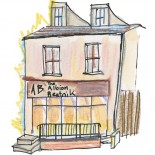 I had a private viewing of the Romanian National Opera House at Cluj. I saw it first in greyscale silhouette, hints of magnificence; somebody then turned the lights on and I gulped, for I saw history as more than nostalgia or as banal copycat recreation, but as a patina, a lived-in aesthetic. The ceiling painted the same as when it opened in 1906, Cluj then part of the Austro-Hungarian Empire; the fire curtain perhaps the same as that which dropped in front of hapless apparatchiks in the 1970s. The faded cushioned seats, tarnished woodwork, its floorboards in disrepair and curtains hanging (weighted by the dust and cigarette smoke of generations) – each added living history to its theatrical splendour. Compare it, say, to Manchester’s Opera House which was built at nearly the same time, its head hung in shame since, as a bingo hall in the 1980s and now, kitted out in a new and glossy livery, as a commercial host to Take That tribute bands and not much else… Cluj has a fulsome operatic itinerary. It shares its huge stage – as big as Wimbledon’s Centre Court, and it can be extended over the (very deep) orchestra pit – with the Romanian National Theatre.
I had a private viewing of the Romanian National Opera House at Cluj. I saw it first in greyscale silhouette, hints of magnificence; somebody then turned the lights on and I gulped, for I saw history as more than nostalgia or as banal copycat recreation, but as a patina, a lived-in aesthetic. The ceiling painted the same as when it opened in 1906, Cluj then part of the Austro-Hungarian Empire; the fire curtain perhaps the same as that which dropped in front of hapless apparatchiks in the 1970s. The faded cushioned seats, tarnished woodwork, its floorboards in disrepair and curtains hanging (weighted by the dust and cigarette smoke of generations) – each added living history to its theatrical splendour. Compare it, say, to Manchester’s Opera House which was built at nearly the same time, its head hung in shame since, as a bingo hall in the 1980s and now, kitted out in a new and glossy livery, as a commercial host to Take That tribute bands and not much else… Cluj has a fulsome operatic itinerary. It shares its huge stage – as big as Wimbledon’s Centre Court, and it can be extended over the (very deep) orchestra pit – with the Romanian National Theatre.
 Jenő Janovics was its first director who, using his own money to fund the interest on the city’s borrowing, then had built another huge theatre for lightweight shows. In 1918 he was made to move on, and he made operatic camp in this sister theatre, the new home of the Hungarian Opera Company. Today there are still two opera programmes in Cluj! (This attractively built Hungarian variant, which I visited the next day, had to borrow a Carmen from the Romanian Opera Company recently, I was told, as theirs fell ill on opening night.)
Jenő Janovics was its first director who, using his own money to fund the interest on the city’s borrowing, then had built another huge theatre for lightweight shows. In 1918 he was made to move on, and he made operatic camp in this sister theatre, the new home of the Hungarian Opera Company. Today there are still two opera programmes in Cluj! (This attractively built Hungarian variant, which I visited the next day, had to borrow a Carmen from the Romanian Opera Company recently, I was told, as theirs fell ill on opening night.)
 I listened to the editor of his biography (I am reading it now), a director at the current National Theatre, tell remarkable stories of Janovics, who started his career as an impoverished actor in Budapest. A life of remarkable achievements. For instance, single-handedly he created a profitable Romanian film industry. He struck a deal with the Pathé Frères Co, made his first silent film in 1913 using the theatre’s players; by 1920 he had produced 66 films, founded 3 production companies, opened 26 cinemas. The early directors he hired included Sándor (aka Alexander) Korda and Michael Curtiz (Casablanca et al).
I listened to the editor of his biography (I am reading it now), a director at the current National Theatre, tell remarkable stories of Janovics, who started his career as an impoverished actor in Budapest. A life of remarkable achievements. For instance, single-handedly he created a profitable Romanian film industry. He struck a deal with the Pathé Frères Co, made his first silent film in 1913 using the theatre’s players; by 1920 he had produced 66 films, founded 3 production companies, opened 26 cinemas. The early directors he hired included Sándor (aka Alexander) Korda and Michael Curtiz (Casablanca et al).
An incredible man, whose mustached, alabaster yet jovial bust winked at me in the foyer. Yet his nameplate is missing, and the theatre’s history, etched on the wall behind, like the grand entrance to the theatre where there is a barely visible trace of its original Hungarian typography, is a palimpsest of history, crayoned over in 1918, the year Janovics was ousted, the year Cluj became part of the new Romania. It all happened again in 1945, Janovics recalled to be in charge of his first theatre (Cluj again part of Hungary), to be shunted aside when post-war treaties made the Cold War a probability, and returned Cluj to Romania.
















